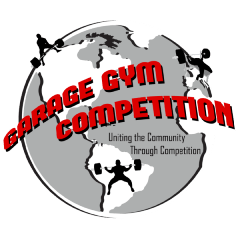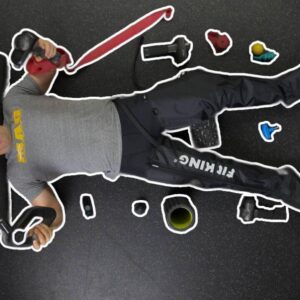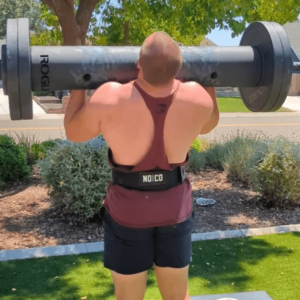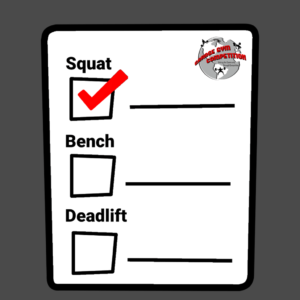Programming vs Working Out
Over the last several years I’ve seen a distinct line being drawn between the term “working out” and “training” or programming. The idea being that working out has no distinct goal outside of getting some exercise in, where as training takes place to help you achieve something bigger. It might be for a sport, it might be a bigger total in powerlifting, it might be to prepare for your daily requirements as a first responder. Neither is necessarily right or wrong, but you SHOULD have an idea as to which one you are doing, and why. Lets take a look at the difference between a good workout and a good program.
Table of Contents
Key Notes
Are you Training or Working out? The difference might just determine whether you make progress in the gym or not.
Transparency Note
Some of the items and links in this article might be affiliate links, or might be linked to a Sponsor of the Garage Gym Competition. These links and sponsorships help fund the website, the competition itself, the newsletter, non-profit donations, and everything else we do FOR FREE here at the GGC. I like to be transparent so you know what is up. I appreciate the support if you choose to use the links.
Working Out
In years past I was always focused on individual workouts. How could I cram every nasty bit into a leg day to make it legendary? How could I crush back from every angle? Was this workout going to make me the best gains possible? This mentality was largely stemmed from a background in bodybuilding, following some of the more ENHANCED dudes, and just not really knowing what I was doing. I had this idea that you needed to have your best workout ever, every time you entered the gym. And the only way to do that, was to go crazy.
I was constantly looking for that next thing. That next way to bump up my workouts. Blood Flow Restriction was a common addition. Drop sets and super sets. Things that were aimed at simply doing MORE and MORE until we couldn’t. I remember leg days on Sundays where I had to take a nap afterwards, eat a plate of pancakes, and then rest on the couch watching TV until my wife came home. I was useless after those workouts. They were fun, in the most insane way possible. There is something enjoyable about doing stuff that no one else does.
Programming
In recent years I’ve moved away from focusing on individual workouts, and more focusing on an overall program. I learned a lot from my experience with The Paradigm Shift, as well as working with Travis “PapaBear” Rogers.
Modulating intensity and volume throughout a block, instead of just sending it into high gear from Day 1. Looking at 4 to even 16 weeks into the future, assessing weak points and growth areas, and building a plan to attack and grow and move forward. Each week was built upon the previous one, and each block was taking advantage of the last. They all built into a proper peak where you were ready to rock and crush your PRs. You could see from the beginning, to the end, and know what you were working towards.

The idea wasn’t that each individual workout had to be a 10 out of 10. In fact that is probably detrimental to long term, sustainable progress. Instead we needed to be more methodical and program progression into our weekly workouts. Some workouts were there to increase repetitions, some were hard and heavy, some were both. But you had a plan that looked at the entire layout to make sure you were moving forward.
What This Looked Like In My Gym
Because my lifting was historically so focused on the individual workout, I always had people limping out of the gym. Leg day was 20+ sets of brutal nastiness, plenty of intensity techniques and bands and chains and whatever else I could think of. We always dragged the sled which is an easy way to make people huff and puff and fall over in exhaustion. Basically, I wrecked people and they left knowing I was the king of nasty workouts. I had a friend tell me I would have made a good scientist because of how gnarly my experiments were in the gym.
When I transitioned to a more cohesive programming perspective, I had people come over and the view of the workouts changed. They would do a workout that was part of a cohesive program, built around a five day lifting schedule, and four weeks of progression models built in, and they just wouldn’t be THAT beat up afterwards. I’m not saying we didn’t work hard, but a workout where you know you are building to more leaves some in the tank ON PURPOSE.

They aren’t crazy volume, or crazy intensity. There aren’t any drop sets, rest pause sets, or anything like that. There is plenty of heavy, compound, and focused work, combined with accessories that all have a progression model built in to continually drive change. From a single workout perspective, that really isn’t too exciting. Because again, the view is focused on a multiple week program, not how badass a single workout is.
Progress
The interesting part is when you compare my progress between the two approaches. My progress during my singular workout approach phase was mediocre at best. I’m pretty sure I simply maintained, but never progressed. Workouts were always difficult. I ALWAYS worked hard. But the only plan was nasty workout after nasty workout after nasty workout. Jump to my program approach, and my lifts go up, my body composition gets better, more muscle, you name it.
I struggled to get much past a 400lb squat, 315lb bench, and 500lb deadlift in my days of workouts. Move to my past several years of programming. I now have a 505lb squat, 365lb bench, and 630lb deadlift. And my body weight? I’m about 10lbs heavier with less bodyfat. I feel better, move better, and I still have energy left to run around with my daughter, even after a leg day.
What Should I Do?
You still need awesome workouts to make up an awesome program. Going in and doing lack luster lifts day in and day out isn’t going to work. So don’t think we aren’t going to work hard no matter what approach you take.
There are a lot of awesome “workout” style programs you can follow. Companies like Street Parking specialize in CrossFit style workouts that can be performed EVERY day. They have a ton of them, in different fashions, with different equipment needs. Their goal is for you to work hard, consistently, to see results. Their programs are not likely to maximize your ability to have a bigger total, or run the fastest you can, or be the most jacked you can be. But they will be fun, exciting, difficult, and keep you coming back over and over.
Flip that with something like JuggernautAI where the App learns about who you are, what works for you, what doesn’t, and tailors the programming TO YOU. The more you use it, the more it adjusts to be the right fit for you. It is based on the goal of a bigger total in powerlifting (or simply getting stronger on the Big 3), and it builds the program in accordance with you and that goal.
Street Parking is literally called Daily Programming. JuggernautAI is focused on the sum of the whole. They are different beasts that both work, but have different audiences and goals.

You Can’t Tell Me What To Do!
You might be here and thinking that my stance is… Programming is better than workouts. But in reality, I don’t think so. There is probably a time and a place for both. If you are just doing a fun workout with your bros, pull out the psycho mindset and destroy everyone with every nasty trick you have in the books. If you are keeping things alive and moving during your families summer break, a workout is fantastic. I’ve had many of workouts during times of crazy life stuff. Or maybe you really don’t care as much about your Total, even though you plan to compete in the next Garage Gym Competition. Then by all means, crush some fun and intense workouts.
If you are looking to make progress in strength, size, and more, especially as a natural athlete looking to reach your highest potential, you are likely best to put a full plan in place that allows you to not only work hard, but to work smart. Leave the brutal nasty YouTube workouts for the guys on gear and for the occasional bro session. Focus on piecing together day to day, week to week, and block to block. You’ll have more sustainable growth that will continue to compound over time.
📌Enjoy Powerlifting? Want to enter a FREE competition with thousands of dollars in prizes and donations to non-profits? Check out our next event!
🏅 Own a home gym? Like to save money? Check out my full list of discount codes.



